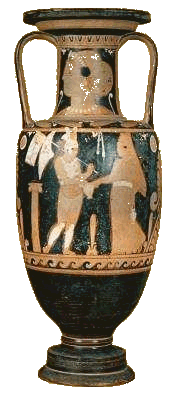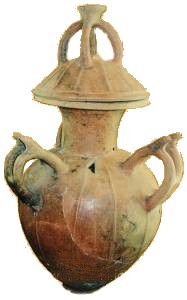 he
Samnites were among the first inhabitants of Molise. Subdivided into five
tribes: Caraceni, Irpini, Caudini, Pentri e Frentani; they dedicated themselves
to sheep farming, and being courageous warriors; they also earned a living
acting as mercenaries.
he
Samnites were among the first inhabitants of Molise. Subdivided into five
tribes: Caraceni, Irpini, Caudini, Pentri e Frentani; they dedicated themselves
to sheep farming, and being courageous warriors; they also earned a living
acting as mercenaries.
The territory was organized into little villages
called vici. The principal ci ties of Molise were: Isernia, Trivento, Sepino,
Larino (capital of the Frentani), Boiano, (capital of the Pentri). The center
of worship (Santuario) was Pietrabbondante. The magistrate of the city was
called Maddix.
ties of Molise were: Isernia, Trivento, Sepino,
Larino (capital of the Frentani), Boiano, (capital of the Pentri). The center
of worship (Santuario) was Pietrabbondante. The magistrate of the city was
called Maddix.
According to tradition, the Samnites are native to Sabbinia; others claim
that following a “Ver Sacrum” (an emigration) they arrived at a hill called
“Saminnium”. The “Ver Sacrum” is a dedication made to a divinity (Ares –
Mars), from all the men
and animals born in a determined year. The young, once mature (20 yrs old)
were forced to abandon the communities to which they belonged (instead of
the antique usage of human sacrifice) and to set out in search of new lands.
They were led on this voyage of theirs by a sacred animal (a wolf, a bull
or a woodpecker) whose name often referred to the group (Irpini, Pentri,
Piceni). Sometimes there was a Dux (a leader of the city militia) who guided
them. The origin of the Ver Sacrum has its roots in the outbreak of famine
and the constant need of new fertile lands as a result of population growth.
They spoke the language of Osca, and therefore belonged
to the Osco –Umbri. There is a precious archeological example, the famous
Table of Agnone (photo), on which
the Oscan alphabet is inscribed. It is being exhibited at the moment in
London at the British Museum. The territory of Morrone was disputed between
the Pentri and the Frentani. As a result of the subdivision made by Emperor Augusto in the 2nd century A.D., along with Apulia (Puglia), Morrone was
incorporated into the Frentano thus becoming part of the second region.
In commercial exchanges barter was the most popular practice. In very early
times money had not yet been minted.
The five Samnitic tribes, with a collective population of around 600,000,
would join forces in the case of war. The dead were buried face up in the
grave. An “olla” vase (similar to an urn) filled with a supply of food was
placed on the feet of the dead. 
Offering
one’s daughter in marriage to the first man that came forward was not permitted.
Every year the most beautiful girls were selected and they got married to
the most courageous young men. If a young man behaved dishonorably he was
deprived of his wife and alienated from his tribe. Among the many wars carried
out by the Samnites, the ones against the Romans marked their disappearance
and their end as a tribal entity. These wars were waged for the supremacy
of the territory.
There were three Holy Wars. At the end of the 1st Holy War in 321 B.C.,
the Roman Army, defeated at the “Caudinian Forks”, was forced to undergo
the humiliation of passing under the giogo. The giogo was a fork-like object
constructed from two vertically positioned rocks with a third placed horizontally
on their ends, thus forming a structure similar to a doorframe. In this
antique practice, defeated enemies were forced to pass under the giogo so
as to humiliate them.
A year later in Lucera, in 320 B.C., there was the 2nd Holy War in which
the defeated Samnites, as a retaliatory act were forced by the Romans to
undergo the same humiliation of passing under the giogo...The 3rd Holy War
concluded in 292 B.C. and represented the definitive defeat of the Samnites.
As a result of this defeat all of their territory remained under firm Roman
dominion and was divided into districts represented by town councils, Morrone
belonging to the municipal of Larino.
 Il comune informa
Il comune informa 


 ties of Molise were: Isernia, Trivento, Sepino,
Larino (capital of the Frentani), Boiano, (capital of the Pentri). The center
of worship (Santuario) was Pietrabbondante. The magistrate of the city was
called Maddix.
ties of Molise were: Isernia, Trivento, Sepino,
Larino (capital of the Frentani), Boiano, (capital of the Pentri). The center
of worship (Santuario) was Pietrabbondante. The magistrate of the city was
called Maddix. 